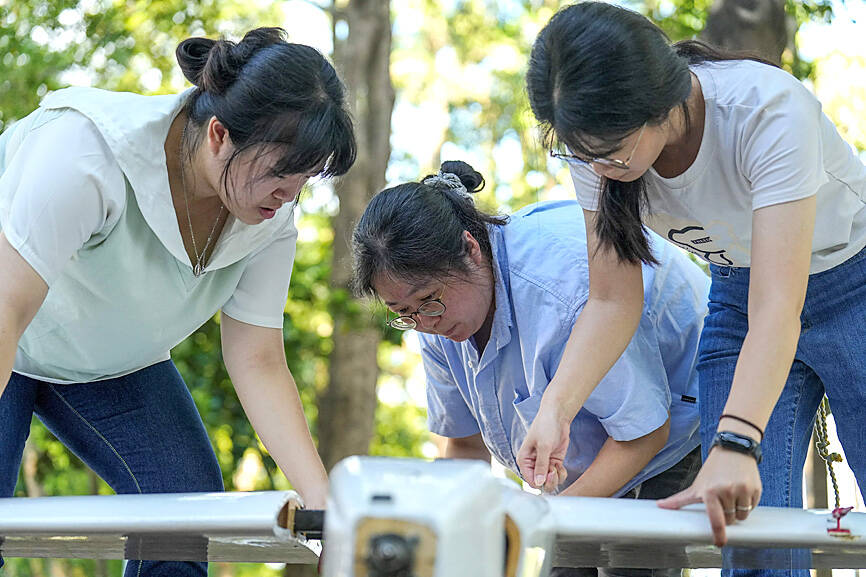At a drone testing field in southwestern Taiwan, university students watched anxiously as uncrewed aerial vehicles (UAVs) they designed took off, landed and, occasionally, crashed in a simulated battlefield scenario.
They are participating in a competition that is helping the nation’s efforts to boost domestic drone production.
With Beijing sustaining military pressure on Taiwan, Taipei is ramping up investment in UAVs, as it seeks to bolster a more agile defense against a potential Chinese attack.

Photo: Walid Berrazeg, AFP
Ukraine and Russia have used UAVs extensively throughout their conflict, for surveillance and striking targets deep behind front lines.
The UAVs flying in the National Defense Application UAV Challenge could potentially be adopted by drone companies and procured by the government.
“We can see drone applications in many current conflicts happening around the world,” said competition organizer Jan Shau-shiun (詹劭勳), a professor in the space systems engineering department at National Cheng Kung University.
“Taiwan is in a position where we might also face such an issue, so based on this theme, we aim to strengthen our drone capabilities,” he said.
Now in its second year, the competition was held over two days last month at the Asia UAV AI Innovation Application R&D Center in Chiayi County.
Twenty teams from across the nation gathered to put their drones to the test. The field would be whittled down to a shortlist this month for another challenge before the winner is declared next year.
Multirotor and fixed-wing drones were required to fly autonomously to a height of at least 60m, take images of a remote target and return to base within 10 minutes. To make the scenario more realistic — and difficult — organizers this year used a jammer to disrupt satellite signals to the UAVs, making it harder for them to stay airborne.
“From observing the war in Ukraine and other conflicts, we can see that there’s often interference on the GNSS [Global Navigation Satellite System] before any fighting,” Jan said.
After spending countless hours designing and building their drones, with help from local drone or electronic component companies, teams watched nervously as their UAVs took flight. Some drones failed to reach the required height or crashed due to the jamming.
Cheng Yong-jen, 24, breathed a sigh of relief after the drone he helped design ascended, soared into the distance and safely returned.
“It crashed, we repaired, it crashed again and we repaired again,” said Cheng, a graduate student from National Formosa University. “When the drone finally descended, I was in tears.”
Lin Chun-liang (林俊良), lead judge and professor of electrical engineering at National Chung Hsing University, said the competition helped students develop “hands-on skills” not taught in schools.
The government is spending hundreds of millions of dollars to buy and develop drones, and also nurture local talent to work in the sector, as it races to upgrade its military capabilities.
President William Lai (賴清德) has pledged to make Taiwan “the Asian hub of unmanned aerial vehicle supply chains.”
However, keeping workers in the industry is a challenge in a country where the huge semiconductor sector can offer higher salaries to top graduates.
Cheng said he planned to join a drone company after finishing his master’s thesis on defense UAVs, adding that “this is the path we must take.”
“We cannot stop moving forward just because we are behind others,” Cheng said.

The first two F-16V Bock 70 jets purchased from the US are expected to arrive in Taiwan around Double Ten National Day, which is on Oct. 10, a military source said yesterday. Of the 66 F-16V Block 70 jets purchased from the US, the first completed production in March, the source said, adding that since then three jets have been produced per month. Although there were reports of engine defects, the issue has been resolved, they said. After the jets arrive in Taiwan, they must first pass testing by the air force before they would officially become Taiwan’s property, they said. The air force

GLOBAL: Although Matsu has limited capacity for large numbers of domestic tourists, it would be a great high-end destination for international travelers, an official said Lienchiang County’s (Matsu) unique landscape and Cold War history give it great potential to be marketed as a destination for international travelers, Tourism Administration Director General Chen Yu-hsiu (陳玉秀) said at the weekend. Tourism officials traveled to the outlying island for the Matsu Biennial, an art festival that started on Friday to celebrate Matsu’s culture, history and landscape. Travelers to Matsu, which lies about 190km northwest of Taipei, must fly or take the state-run New Taima passenger ship. However, flights are often canceled during fog season from April to June. Chen spoke about her vision to promote Matsu as a tourist attraction in

PAWSITIVE IMPACT: A shop owner said that while he adopted cats to take care of rodents, they have also attracted younger visitors who also buy his dried goods In Taipei’s Dadaocheng (大稻埕), cats lounging in shops along Dihua Street do more than nap amid the scent of dried seafood. Many have become beloved fixtures who double as photography models, attracting visitors and helping boost sales in one of the capital’s most historic quarters. A recent photo contest featuring more than a dozen shop cats drew more than 2,200 submissions, turning everyday cat-spotting into a friendly competition that attracted amateur and professional photographers. “It’s rare to see cats standing, so when it suddenly did, it felt like a lucky cat,” said Sabrina Hsu (徐淳蔚), who won the NT$10,000 top prize in

STRIKE: Some travel agencies in Taiwan said that they were aware of the situation in South Korea, and that group tours to the country were proceeding as planned A planned strike by airport personnel in South Korea has not affected group tours to the country from Taiwan, travel agencies said yesterday. They added that they were closely monitoring the situation. Personnel at 15 airports, including Seoul’s Incheon and Gimpo airports, are to go on strike. They announced at a news conference on Tuesday that the strike would begin on Friday next week and continue until the Mid-Autumn Festival next month. Some travel agencies in Taiwan, including Cola Tour, Lion Travel, SET Tour and ezTravel, said that they were aware of the situation in South Korea, and that group